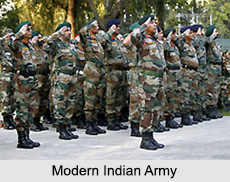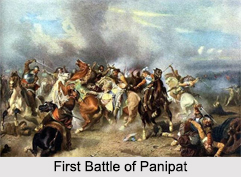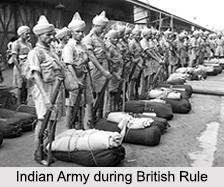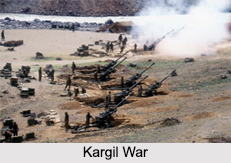 History of Indian Army is imbibed with real and true accounts of extraordinary heroism and valour. It can be traced back to the ancient periods in India. The earliest mention of Indian Army is found in the ancient texts and scriptures, including the Vedas and the epics Mahabharata and Ramayana. The History of Indian Army emphasises that Indians have not taken to the science of warfare recently and their fighting traditions are not merely 200 years old. There are several glorious instances of large scale operations undertaken in ancient times backed by a definite military science based on brilliant strategy and tactics. During the ancient period, when Dharma played such a dominating role in the daily routine of a person, Warfare had to be undertaken frequently. The epitome of Dharma Yuddha, as it was originally known as, is to be found in the two Indian epics namely the Ramayana and the Mahabharata. No base means were used and the dignity of man as a warrior, victor and vanquisher was maintained always. History of Indian Army mentions that in ancient India the organization of the army altered with changing dynasties.
History of Indian Army is imbibed with real and true accounts of extraordinary heroism and valour. It can be traced back to the ancient periods in India. The earliest mention of Indian Army is found in the ancient texts and scriptures, including the Vedas and the epics Mahabharata and Ramayana. The History of Indian Army emphasises that Indians have not taken to the science of warfare recently and their fighting traditions are not merely 200 years old. There are several glorious instances of large scale operations undertaken in ancient times backed by a definite military science based on brilliant strategy and tactics. During the ancient period, when Dharma played such a dominating role in the daily routine of a person, Warfare had to be undertaken frequently. The epitome of Dharma Yuddha, as it was originally known as, is to be found in the two Indian epics namely the Ramayana and the Mahabharata. No base means were used and the dignity of man as a warrior, victor and vanquisher was maintained always. History of Indian Army mentions that in ancient India the organization of the army altered with changing dynasties.
Ancient History of Indian Army
Indian Army in the ancient period describes that the Rig Vedic tribes of Indo-Aryans engaged in warfare with other tribes, as well as with each other. The Rig Veda describes the utilization of horse-drawn chariots set with spikes and weapons constructed with bronze. The other weapons that were commonly employed from the earliest times until about 1000 AD were primarily bow and arrow, sword, spear and axe. A large number of other weapons were also employed as is evident from the ruins of Mohenjodaro, Sanchi, Udaigiri and Harappa. The infantry and cavalry used a long cylindrical pipe and fired it in the manner of firing a gun relevant in the modern times. This would indicate the active use of gun-powder in ancient India. Further, the ancient army was composed of the infantry, cavalry, chariots, elephants and a commissariat department. Even the admiralty or position constituted a separate department.
 The higher echelons of command were very well organised and as a whole were considered to be a very efficient system with a large number of military dignitaries and officials. The duties of each person were laid down in great details. This could only happen because of a deep study of the art of war. The composition of the armed forces and employment of balanced forces kept on varying according to the needs of the changing times. Ample utilisation of intelligence strategies was made and the securing of decisions was made on the basis of means rather than depending on hostilities. Even though chariots and horses were employed, they were more for dignity and show than for obtaining tactical superiority.
The higher echelons of command were very well organised and as a whole were considered to be a very efficient system with a large number of military dignitaries and officials. The duties of each person were laid down in great details. This could only happen because of a deep study of the art of war. The composition of the armed forces and employment of balanced forces kept on varying according to the needs of the changing times. Ample utilisation of intelligence strategies was made and the securing of decisions was made on the basis of means rather than depending on hostilities. Even though chariots and horses were employed, they were more for dignity and show than for obtaining tactical superiority.
Later Ashoka formed the espionage section in his army to protect his states. Conquest of the Nanda Empire between the Mauryas and the Nandas (321 BCE–320 BCE) and Kalinga War between the Kalingas and Mauryas (262 BCE–261 BCE) are two wars fought in ancient India.
Medieval History of Indian Army
In the Medieval period the Indian Army was completely standstill in the military thought, until the Hun invasion in the country, who penetrated deep into the Gangetic plains and up to the Vindhyas in the south. Thus, with the Muslim invasion in the country, the Indian army, in various parts of the country, was well-knit and extremely organised, much in the same manner as before. However, they still lacked mobility. The infantry provided the bulk of the forces. Small well-trained armies still formed the nucleus, while the bulk was provided by the vassals and dependents. When the Afghans started their in-roads into the country through the passes in the north-western direction, there was again complete standstill as regards the military thought.
 Especially in the time of Akbar, the army was united and it was the real picture of the Medieval history of Indian Army. Although the Muslim rulers had by now firmly established themselves in the country, they did not add anything new to the army organisation. Thus, at this stage the emphasis shifted to the cavalry as they had to undertake regular campaigns in far off lands. A small standing army was maintained at the centre as body-guards mainly for the immediate defense of the capital. Military associated details were also properly maintained under provincial governors. The Rajputs, who earlier formed the military classes, were replaced by the new rulers and their own co-religionists.
Especially in the time of Akbar, the army was united and it was the real picture of the Medieval history of Indian Army. Although the Muslim rulers had by now firmly established themselves in the country, they did not add anything new to the army organisation. Thus, at this stage the emphasis shifted to the cavalry as they had to undertake regular campaigns in far off lands. A small standing army was maintained at the centre as body-guards mainly for the immediate defense of the capital. Military associated details were also properly maintained under provincial governors. The Rajputs, who earlier formed the military classes, were replaced by the new rulers and their own co-religionists.
During a brief spell of around a hundred years, the Sikhs also organised themselves into a military class. Their evolution is considered as another milestone in the military history of the country. The Mughal-Rajput Wars (1525–1750), First Battle of Panipat (1526), The Deccan Wars between Mughals and the Maratha Empire (1681-1707) are some examples of wars and insurgencies during the medieval period.
History of Indian Army during British Rule
History of Indian army during British rule depicts that it became more structured and more organised. Although India has been ruled over by several foreign kingdoms but Her interests and borders were always secured by the sons of the soil. Even under the British rule, the revolt against the colonisers was initiated by men in uniform. During the reign of the emperors, the loyalty of the soldiers lay with their kings and during later periods, this entire concept underwent huge changes. This mainly occurred due to the rise of the concept of Nation. Under the British rule, the army was organised completely on a foreign pattern, designed only to suit British ends and interests in the country and to fight their battles in other countries that were as far as China and Europe.
The Indian National Army (INA) or Azad Hind Fauj was not the fifth columnist of the Japanese Army but the independent Indian army found by Netaji Subhas Chandra Bose. It was an armed force in 1942 in Southeast Asia during World War II. The aim of the army was to liberate India from the British occupation with Japanese assistance. It was initially composed of Indian prisoners of war captured by Japan in the Malayan campaign and Singapore. The army later drew the direct assistance of thousands of Indians living in Myanmar. The INA also was at the forefront of fighting for women`s equality and the formation of a women`s regiment. The Rani of Jhansi regiment was formed as an all women`s unit to fight the British occupiers as well as to provide medical services to the INA.
 It can be denoted as the independent Indian Army before independence. Operation Masterdom (1945-1946), World War 2 (1939-1945), Iraqi Revolt (1920), Third Anglo-Afghan war (1919), Allied Intervention in Russian Civil War (1918-1920), World War 1 (1914-1918), etc are some of the military participations of the Army under British rule in India. Under the East India Company rule in India, the military wars fought were the Battle of Plassey (1757), First, second, third and fourth Anglo-Mysore wars (1757-1799), The First Opium War (1839-1842), and the Indian Rebellion of 1857, among many.
It can be denoted as the independent Indian Army before independence. Operation Masterdom (1945-1946), World War 2 (1939-1945), Iraqi Revolt (1920), Third Anglo-Afghan war (1919), Allied Intervention in Russian Civil War (1918-1920), World War 1 (1914-1918), etc are some of the military participations of the Army under British rule in India. Under the East India Company rule in India, the military wars fought were the Battle of Plassey (1757), First, second, third and fourth Anglo-Mysore wars (1757-1799), The First Opium War (1839-1842), and the Indian Rebellion of 1857, among many.
Indian Army in Modern India
Modern India has witnessed several valorous soldiers who have laid down their lives for their motherland. The names of such warriors have been immortalised in the history of Indian army. Whether in the Indo-China Conflict or the Kashmir attacks, Indian military history states, with pride, that their troops have always successfully forced the invaders to retreat. In fact, whenever the outsiders have tried to disturb the harmony and peace of India, the Indian army has marched to the battleground and vanquished the trespassers. The Indo-Pakistan War (1947-1948), The Kargil War (1999), Bangladesh Liberation War (1971), The Indo-Pakistan War of 1965 and 1971, The Naxalite-Maoist Insurgency (1967-present), Siachen Conflict (1984-2003), Sino-Indian War of 1962, Annexation of Goa (1961), The Congo Crisis War (1960-1964), Dadra and Nagar Haveli Integration (1954) and the Operation Ocean Shield between NATO and Non-NATO (2009-2016) are some of the military missions of Modern Indian Army.
History of Indian Army shows that since ancient times a conventional method of warfare was followed. Hence the structure, strength and the policies differed in the various empires, but what remained unaltered, was the undeterred bravery with which the courageous men faced their foes. Indian Army that is well regarded as the epitome of chivalry, gallantry and intrepidity, is the subcontinent"s guardian against all kinds of intrusions. The Indian army assures and makes certain that every civilian can assuredly retreat to slumber whilst they are guarding the border of the nation round the clock, with their lives, with highly developed and technically advanced weapons and best strategic planning.






